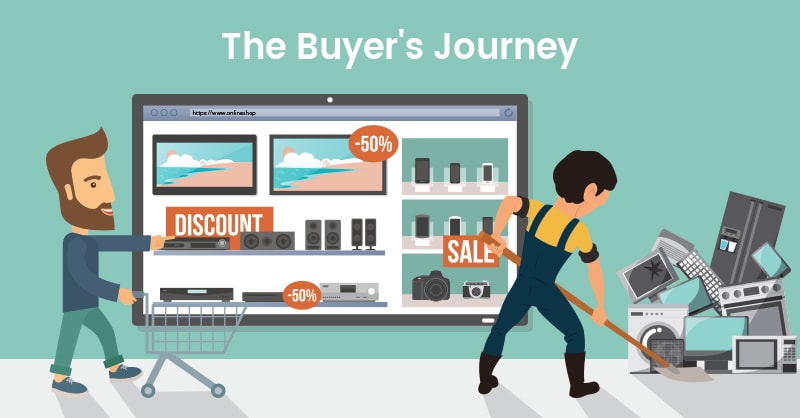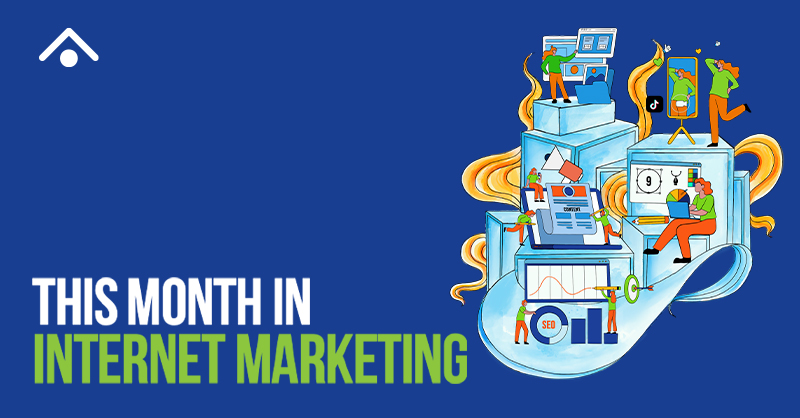A common misconception about selling is that a business is selling a product or service. However, what any business is selling (from a large, layered corporation like Coca-Cola to a small mom and pop shop selling specialized teas) are solutions to customer problems.
Bill is looking to buy something sweet. How about a coke?
Sarah is looking for a relaxing tea to have before bed. Have you tried this Cinnamon Chamomile Tea?
Before your product is purchased, your customer has gone through a decision making process that sometimes begins before they know even what product they actually need. Digital disruption now allows business owners to measure and track how their past, present, and future customers are finding them and take away any barriers that may be stopping them from finding your business as their optimal solution.
The Buyer's Journey
The Buyer's Journey is comprised of five core states: Need Awareness, Information Search, Evaluation of Alternatives, Purchase Decision, and Post-Purchase Behaviour. However, the steps are sometimes named differently in the digital age.
Before the rise of technology which tracked these steps digitally, and even before Engel, Balckwell and Kollat coined these terms in their 1968 book "Consumer Behavior," we've had a process to solve problems. For example, while looking to keep food from spoiling in the summer heat, the first solution humankind devised wasn't what we use today -- a fridge -- and didn't involve the cold at all. In fact, it was salt.
Getting the right product in front of the right person now is both much easier and harder than it was the past: the internet brings everything to your fingertips but increasingly small market barriers make competition fierce.
Let's try and sell a simple product, a high performance, high cost spade shovel, and take a look at the modern online buyer's journey.
Need Awareness
You've designed, manufactured, and readied your top of the line shovel and it's ready for market. Properly defining and targeting the market for that shovel is mission critical. Is it for the weekend warrior doing work around the house? The labourer using it five days a week, eight hours a day? Each market has different problems and tactics needed in order to solve their problems and get your shovel in their hands.
If you're targeting the weekend warrior/homeowner, a B2C target market, we need to inspire or motivate them in order to create need. This is where a strategy of content marketing would be highly effective: YouTube video How-To's involving the shovel and yard work, blog posts syndicated via Reddit, and other places your homeowner may be looking for answers or inspiration.
By showcasing the problems your product solves, your target market can now decide that they have a need: to dig a hole.

Information Search
Now that your potential customer has established a need, they are off to find the perfect solution. This is where you need to be well placed in their search. Ideally, you'll want to rank organically on Google.
Easy peasy.
But not: Google is the preferred search engine for 75% of internet users and dominates 30% of all digital ad revenue. This means competition is fierce, ugly, and a game of survival of the fittest.
Your shovel website may have the most aesthetically pleasing shovel pictures with a modern, minimalist theme that speaks to your brand, but to Google you might as well be a site about marbles. When doing a crawl, Google will be searching for relevant keywords for your product and, if your keywords aren't on the page, you won't exist in SERPs.
Your page needs meta descriptions, picture tags, headers, and everything to do with On-Page SEO just to get on the dance floor, let alone dominate the competition. Your Off-Page SEO, including backlinks from reputable websites and their domain authority, give your site credibility to Google, boosting your page rank and getting your shovel in front of the right eyes first.
Careful keyword planning in the design and development stage of your site will get you off on the right foot in your quest to dig your customer's hole.
Special interest should be made to long-form search queries. "Spade shovel" is good, but "best shovel for digging in hard clay" is a long-form question your customer may be asking. This campaign by IKEA, renaming products directly in their online store to search questions, is a brilliant example of this.

Evaluation of Alternatives
While 53% of all organic search clicks go to the first link, today's online customer is much more savvy than to use the first product offered to them. This is where having firm control over your online reputation management is critical.
Negative reviews can follow you around like a bad cold, infecting not only your customer's journey but also how reliable you are in Google's eyes. Staying on top of and responding to reviews, on all of your communication channels (social media, Google, and professional services sites), allows you to both contain bad reviews and promote great feedback. It can be easy to ignore the bad reviews as they come in as a few rotten apples, but taking time to respond and attempt to rectify these complaints shows your brand has an attention to detail and a high level of customer service.
While during the design stage of your site, hopefully you were able to stay away from feature overload and communicated on how your shovel directly benefits the customer. The ergonomic design? It eliminates back pain. The sturdy alloy shovel head? Able to cut through the toughest dirt. This benefits over features focus can act as a problem solver for your potential customer and is a perfect strategy for ...
Remarketing!
Once your potential customer has left your site, it isn't the end. Harness the power of Google's Display Network and get them back on the horse. Your shovel can follow your customer around on sites all across the Internet, reminding them how great you are. If they venture away from the path you've carefully left for them, make sure you make it easy for them to find their way back.

Purchase Decision
The alternatives have been researched and your target has decided to choose you. Now it's time to make it very clear and very easy for them.
Conversion Rate Optimization for your site, eliminating the obstacles for your potential customer in either contacting you directly or buying your product on your site, can mean the difference between being the king of shovel manufacturers or thinking no one wants your product.
Having your phone number at the top right of your page, having clear calls-to-action on each of your pages, and distinguishing your CTA's with colour cues can all drive your customer to convert. They are already interested, so making their buying process overly complicated could be leaving a bunch of money on the table that should be in your pocket. Simplifying form fields and cutting down on unnecessary information collection gets you to your customer sooner.
Make it easy to find your product, contact you for your product, and buy your product.
Post-Purchase Behaviour
The in vogue term for this stage is now "evangelizing," but there is much more to do here than just making sure your customer is spreading the good news about the great hole they dug. Word-of-mouth marketing is a by-product of sound post-purchase behaviour strategies and tactics, keeping your brand top of mind and tip of tongue.
Encouraging Google reviews and newsletter sign-ups can both boost your online reputation and your brand awareness, while your own internal CRM and sales team should be aware of your customer's last touchpoints (may I recommend AdLuge? FULL DISCLOSURE: I'm totally biased for this TechWyse produced CRM/Tracking software!) and in getting your prior customer's right back into your journey.
Measuring the success of your buyer's journey design and how customers interact within it is invaluable. The Internet allows you to be digitally dynamic and modify on-the-fly. Encouraging your customers to follow your social media pages and provide feedback allows you to react to customer needs, and not be left in the product boneyard. Even if you insist your company can continue to exist on referrals and word-of-mouth alone, the world isn't getting less digital and these tools are an extension of that tried and true process -- not an elimination.

By leveraging digital tools and planning for every step of the Online Buyer's Journey (and tracking and making adjustments along the way), you'll be giving your business every chance to succeed. Starting with how your product solves a customer problem gives you the proper starting point in designing their buying path and forms the foundation for all of your marketing materials moving forward.
Happy selling!







on
Awesome read Mike! It’s all about solving problems – but as humans we like to make things complicated, when really (like good sales) it doesn’t have to be.
on
I agree wholeheartedly! Thanks for reading!